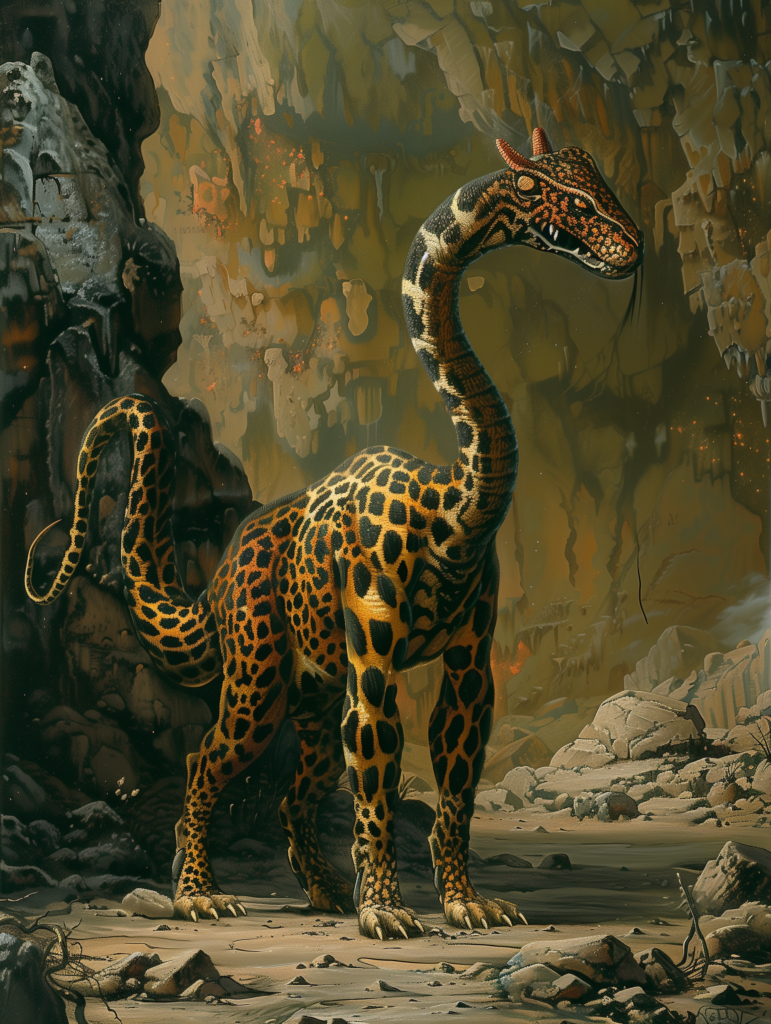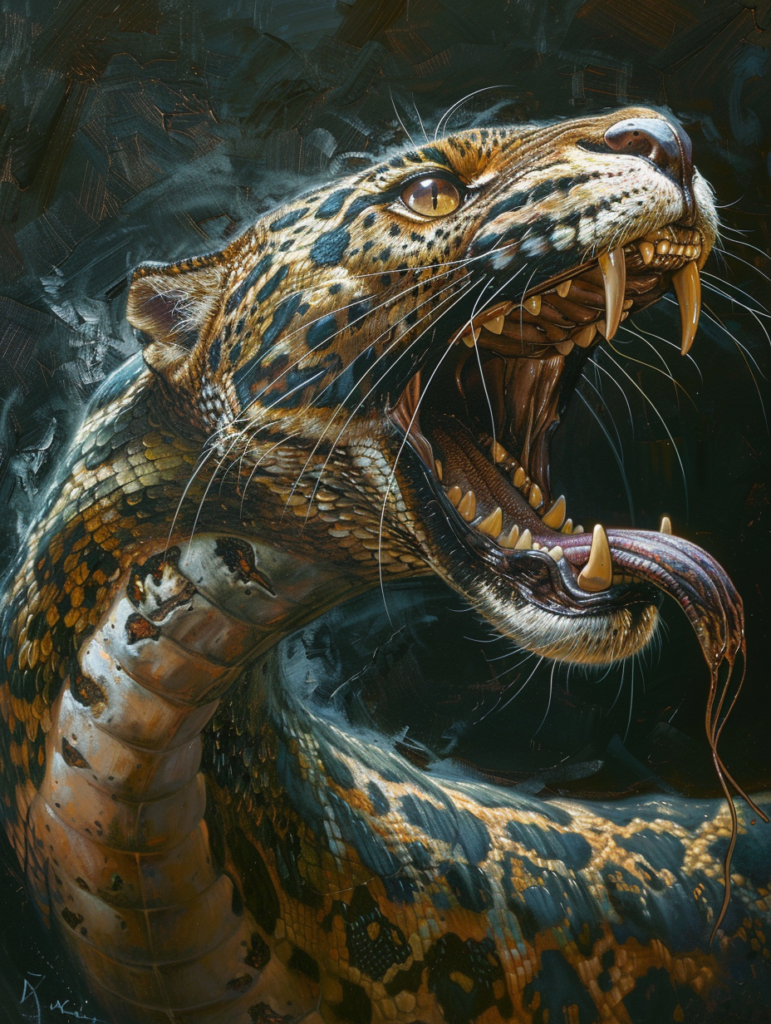Serpopard
“Unveiling the Ancient Guardian: Serpopard, Egypt’s Majestic Hybrid of Leopard and Serpent!”

Appearance: The Serpopard is a rare and enigmatic creature, its form blending the lithe body of a leopard with the elongated neck and head of a serpent. Standing at about 3 feet tall at the shoulder, with fully extended necks reaching up to 20 feet in length from nose to tail, these creatures possess a striking presence. Covered in spotted fur reminiscent of a leopard’s coat, their sleek bodies are accented by the sinuous necks that undulate with serpentine grace. With piercing eyes and sharp teeth, they exude an aura of both elegance and danger.
Behavior: Serpopards are primarily solitary creatures, venturing alone across the vast deserts of their native lands. Largely nocturnal hunters, they rely on stealth and speed to pursue their prey under the cover of darkness. Despite their ferocity in hunting, they are not inherently malicious, often seeking only to secure their next meal. However, they are known to defend their territory fiercely and will not hesitate to confront any threat to their domain.
Habitat & Society: Found mainly in the desolate expanses of desert, Serpopards are intimately familiar with the harsh terrain they call home. They roam vast distances each day, stopping only to hunt, rest, or explore ancient ruins that dot the landscape. Despite their solitary nature, some Serpopards may form temporary bonds during mating season or when rearing their young, although these alliances are fleeting.
Modus Operandi: Skilled hunters, Serpopards use their agility and long necks to their advantage when pursuing prey. Their dune step ability allows them to traverse vast distances across the desert, making them elusive and unpredictable. While they primarily hunt for food, they are known to occasionally attack humanoids if the opportunity arises, although they do not derive pleasure from such acts.
Motivation: The motivations of Serpopards are driven by survival and curiosity. They seek to navigate the harsh desert landscape in search of sustenance and shelter, while also displaying a fascination with ancient ruins and artifacts. Their interactions with other creatures are often transactional, with Serpopards offering their guidance and protection in exchange for food, hospitality, or divination magic. Despite their reputation as skilled deceivers, they can prove valuable allies to those who earn their trust and loyalty.
Serpopard 5e
Serpopard Pathfinder
Serpopard

Medium monstrosity, neutral
Armor Class 15 (natural armor)
Hit Points 84 (8d8 + 48)
Speed 40 ft.
| STR | DEX | CON | INT | WIS | CHA |
|---|---|---|---|---|---|
| 18 (+4) | 16 (+3) | 18 (+4) | 10 (+0) | 14 (+2) | 12 (+1) |
Skills Perception +6, Stealth +5
Senses darkvision 60 ft., passive Perception 16
Languages —
Challenge 5 (1,800 XP)
Keen Senses. The Serpopard has advantage on Wisdom (Perception) checks that rely on sight, hearing, or smell.
Pounce. If the Serpopard moves at least 20 feet straight toward a creature and then hits it with a claw attack on the same turn, that target must succeed on a DC 14 Strength saving throw or be knocked prone. If the target is prone, the Serpopard can make one bite attack against it as a bonus action.
Multiattack. The Serpopard makes two attacks: one with its bite and one with its claws.
Actions
Bite. Melee Weapon Attack: +6 to hit, reach 5 ft., one target. Hit: 10 (2d6 + 4) piercing damage.
Claws. Melee Weapon Attack: +6 to hit, reach 5 ft., one target. Hit: 12 (2d8 + 4) slashing damage.
Dune Step (Recharge 6). As a bonus action, the Serpopard can magically step through the sand, teleporting up to 60 feet to an unoccupied space it can see that is also within 20 feet of another patch of sand.
Camouflage. The Serpopard has advantage on Dexterity (Stealth) checks made to hide in desert terrain.
Desert Hunter. Serpopards have advantage on saving throws against being charmed or frightened while in desert terrain.
Poisonous Spit. The Serpopard spits a glob of venomous saliva at a creature it can see within 30 feet. The target must make a DC 14 Constitution saving throw, taking 18 (4d8) poison damage on a failed save, or half as much damage on a successful one.
Description:
The Serpopard is a rare and elusive creature native to the deserts, possessing the lithe body of a leopard and the long neck and head of a serpent. Its sleek fur blends seamlessly with the shifting sands, allowing it to move with stealth and agility. With keen senses and deadly hunting instincts, the Serpopard is a formidable predator, able to ambush prey with lightning speed. Its ability to teleport through sand and camouflage itself in its environment make it a master of desert terrain, feared and respected by all who dwell within its domain.

The muscles beneath the spotted fur of this sleek feline tense, poised to pounce. Its long, sinuous neck stretches over twice the length of its body, ending in a snarling leopard’s head.
Serpopard CR 7
XP 3,200
CN Medium magical beast
Init +9; Senses darkvision 60 ft., low-light vision, scent; Perception +10
DEFENSE
AC 20, touch 15, flat-footed 15 (+5 Dex, +5 natural)
hp 85 (9d10+36)
Fort +10, Ref +11, Will +7
OFFENSE
Speed 40 ft.
Melee bite +14 (1d6+4/19–20), 2 claws +14 (1d4+4 plus grab)
Space 5 ft.; Reach 5 ft. (15 ft. with bite)
Special Attacks dune step, limber neck, pounce, rake (bite +14, 1d6+4; 2 claws +14, 1d4+4)
STATISTICS
Str 19, Dex 21, Con 18, Int 10, Wis 14, Cha 17
Base Atk +9; CMB +13; CMD 28 (32 vs. trip)
Feats Combat Reflexes, Improved Critical (bite), Improved Initiative, Iron Will, Weapon Finesse
Skills Acrobatics +10 (+14 when jumping), Bluff +9, Climb +8, Knowledge (geography) +5, Perception +10, Stealth +15, Survival +8; Racial Modifiers +4 Acrobatics when jumping, +4 Bluff, +4 Stealth
Languages Common
SQ far wanderer
SPECIAL ABILITIES
Dune Step (Su)
Three times per day as part of a move action, a serpopard can instantaneously leap from one dune to any other dune within 1 mile as if by dimension door. The serpopard must begin and end this movement in an area of dunes. Using this ability does not provoke attacks of opportunity.
Far Wanderer (Ex)
Knowledge (geography) and Survival are class skills for serpopards.
Limber Neck (Ex)
A serpopard can use its long neck to make bite attacks as part of a rake attack against grappled opponents. In addition, a serpopard doesn’t take the usual –2 penalty on attack rolls when it makes a bite attack while grappling.
ECOLOGY
Environment warm deserts or plains
Organization solitary or pair
Treasure standard
Avistani naturalists named this creature serpopard because they saw it as possessing features of both a leopard and a serpent.
Though rare, serpopards are naturally occurring beasts native to the deserts. Superstitious folk who believe that the gods’ hands touch everything beneath the blistering sun see the serpopard as a cursed creature, marked with snake-like features and forced to wander eternally through the desert, never to find rest or sanctuary. On the other hand, carvings on ceremonial plates, on uncovered artifacts, and in ruined temples make it clear that god-kings once kept serpopards as pets or servants, as depictions of these creatures in the oldest of ruins often show them chained or collared, bowing obediently to human masters.
Serpopards stand approximately 3 feet tall at the shoulder; when their necks are fully extended, they can measure up to 20 feet long from nose to tail. Serpopards weigh anywhere from 150 to 200 lbs.
Ecology
Some sages hypothesize that the most powerful or ancient serpopards can cross greater distances with their dune step ability, and thus travel through it to distant deserts. Such experts say it’s therefore likely that all deserts hold populations of serpopards, though they may be few in number or very isolated.
Serpopards are largely nocturnal, preferring to hunt at night when they can use the cover of darkness to approach prey undetected. When hunting, they rely on their speed and powerful claws to take down large quarry, and then use the additional reach provided by their unusually long necks to defend their kills from scavengers and competing hunters. Serpopards are not averse to eating intelligent beings, and hunt humanoids if the opportunity or need arises, but they aren’t cruel— serpopards gain no pleasure from such acts beyond the satisfaction of a fresh meal.
On average, serpopards have a lifespan of about 50 years, but rumors exist of serpopards living much longer than this. One town claims a single serpopard has visited its outskirts once every decade for the past 100 years.
Habitat & Society
Serpopards are mainly solitary creatures. Very rarely do they travel in pairs, and then only during mating season or in the case of littermates who chose not to separate at adulthood. When living as mated pairs, the father stays only until the cubs are able to run, but the mother stays with the cubs much longer, teaching them how to hunt and use their special ability to travel between the dunes.
Mothers also pass on to the cubs their understanding of the land, instructing them as to which areas are good for hunting or exploring, what kinds of places to avoid, and how to find fresh water. Young serpopards separate from their mother individually, leaving as soon as they mature and feel confident navigating their way through the desert alone.
When traveling, serpopards range anywhere from 50 to 100 miles per day, stopping only to hunt, rest, or (more rarely) explore some aged ruin. No one knows what fascination these ancient works hold for the serpopards, but the creatures’ interest in such locations is undeniable.
Serpopards are clever liars and frustrating conversationalists, and hold a reputation among other races as skilled deceivers. Despite this potential untrustworthiness, many people still seek the aid of serpopards.
Few creatures know the deserts as well as serpopards, and for the right price many are willing to guide groups of people across the desert. It’s usually best to ensure the serpopard is well fed before undertaking such a journey, however, for a hungry serpopard may turn on its traveling companions if it thinks it can make a quick meal out of them. Serpopards have little use for gold and rarely accept it as payment for their services, though some apparently take a liking to jewelry, as travelers report the creatures as frequently wearing necklaces and bracelets when encountered.
Food and hospitality are always acceptable payments, for those two things are in short supply in the harsh expanse of the desert. For those wishing to earn a serpopard’s true faith and loyalty, however, one form of compensation stands above all others—divination magic. Serpopards are unceasingly curious about what their futures hold, and put great stock in the words of those who can tell fortunes or predict events to come.
Serpopards attack most sphinxes on sight, often fighting at least long enough to get in a few solid blows before retreating between the dunes to safety. The only exception to this is androsphinxes, which most serpopards fear for some unknown reason. Only the bravest or most desperate serpopards face down such creatures in combat without aid; most flee immediately once they spot these mighty sphinxes. Sphinxes are aware of this antipathy and treat serpopards accordingly.
Perhaps as a consequence of their antipathy toward sphinxes, serpopards also hate riddles and word games, and prefer to twist their words with lies and omissions rather than making a game out of conversation. Ignorant travelers who confuse the two creatures and try to engage the serpopard in a bout of riddling can find themselves in a dangerous predicament.
Section 15: Copyright Notice
Pathfinder Adventure Path #81: Shifting Sands © 2014, Paizo Inc.; Authors: Richard Pett, with Benjamin Bruck, Adam Daigle, Thurston Hillman, Michael McCarthy, Patrick Renie, Amber E. Scott, and Russ Taylor.

 Buy me a coffee
Buy me a coffee